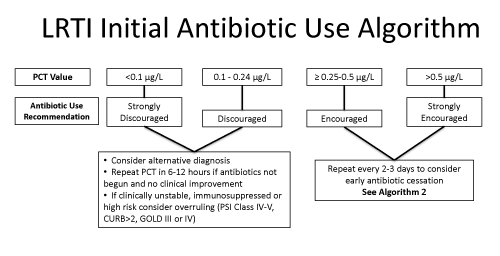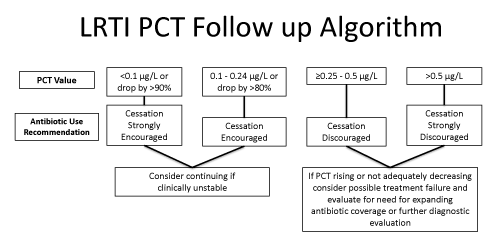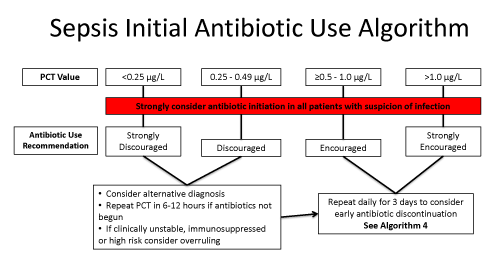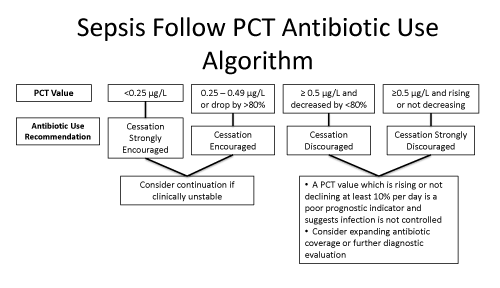Procalcitonin (PCT) Guidance
Procalcitonin (PCT) is a 116 amino acid precursor of calcitonin which under normal circumstances is produced by the thyroid C-cells. Serum concentrations of PCT are normally <0.05 ng/mL but in circumstances of systemic inflammation, particularly bacterial infection, PCT is produced in large quantities by many body tissues. It is detectable within 2-4 hours and peaks within 6-24 hours (as opposed to CRP which begins to rise after 12-24 hours and peaks at 48 hours). 14-16 PCT production is not impaired by neutropenia or other immunosuppressive states. PCT levels parallel the severity of the inflammatory insult or infection meaning those with more severe disease have higher levels. Furthermore, procalcitonin has some utility as a prognostic indicator with higher serum concentrations related to the risk of mortality.
PCT has some advantages other biomarkers in common clinical use such as C - reactive protein (CRP) and white blood cell count. The advantages of PCT over older markers include: specificity for bacterial infection (versus inflammation in general), the rapidity of its rise after an insult (6 hours), the rapid decline with immune control on infection (half-life of 24 hours), excellent correlation with severity of illness (higher levels in more severely ill), and the lack of impact of anti-inflammatory and immunosuppressive states on production
- Differentiation of bacterial versus viral respiratory tract infection
- Determination of antibiotic treatment length in respiratory infections
- Diagnosis, risk stratification, and monitoring of sepsis and septic shock
- Monitoring response to antibacterial therapy
- Diagnosis of systemic secondary infection post-surgery, post-organ transplant, and in severe burns, multiorgan failure, and severe trauma
- Diagnosis of bacteremia and sepsis in adults and children (including neonates)
- Differentiating bacterial versus viral meningitis
- Diagnosis of renal involvement in pediatric urinary tract infections
- Diagnosis of bacterial infection in neutropenic patients
- Diagnosis of septic arthritis
Procalcitonin will be available 24 hours a day and will be run as needed. Stat order results will be available within 90 minutes while results of routine testing will be available during the same shift (usually 2-4 hours). A value of = 0.1 µg/L will be flagged as elevated. Interpretation should be based upon the clinical context and algorithms available on the Antimicrobial Stewardship Website. The specific comment included on the laboratory report is included below:
Normal: <0.1 ng/mL (infants >72 hours – adults)
Suspected Lower Respiratory Tract Infection:
0.1 – 0.25 ng/mL - Low likelihood for bacterial infection; Antibiotics discouraged. >0.25 ng/mL - Increased likelihood bacterial infection; Antibiotics encouraged.
Suspected Sepsis: Strongly consider initiating antibiotics in all unstable patients.
0.1 – 0.5 ng/mL - Low likelihood for sepsis; Antibiotics discouraged.
>0.5 ng/mL – Increased likelihood sepsis; Antibiotics encouraged.
>2.0 ng/mL – High risk of sepsis/septic shock; Antibiotics strongly encouraged.
Decisions on antibiotic use should not be based solely on procalcitonin levels. If antibiotics are administered, repeat procalcitonin testing should be obtained every 2-3 days to consider early antibiotic cessation. PCT is a dynamic biomarker and most useful when trends are analyzed over time in accompaniment with other clinical data. Interpretation should be based upon clinical context and algorithms available on the Antimicrobial Stewardship Website.
Sepsis: PCT levels of >2.0 µg/L predicts sepsis and levels of >10 µg/L indicate likely septic shock. Sensitivity and specificity of PCT for the diagnosis of sepsis has varied based upon population and underlying diseases. Higher PCT levels have been shown to be associated with a worse prognosis, but have not generally added to well validated clinical scoring systems such as APACHE or SAPS.
Febrile Children in the ED: In studies have found PCT values of >2.0 µg/L make a serious infection much more likely while values of <0.5 µg/L make a serious infection much less likely. Values between 0.5 and 2.0 µg/L are equivocal and generally not helpful. Consider repeating in 6-12 hours versus initiating therapy depending on clinical judgment. Decisions on antibiotic administration in newborn patients should be based on clinical judgment.
Bacterial Meningitis: Levels of <0.5 µg/L make bacterial meningitis very unlikely. Most patients with bacterial meningitis have much higher PCT levels (>5 µg/L).
Renal Involvement in Pediatric Urinary Tract Infections: PCT values of >0.5 µg/L have a sensitivity of 70-90% and 80-90% specificity for renal involvement in pediatric patients with UTIs.
False positive and false negative results can occur with any test and clinical context should guide interpretation of PCT results.
Situations where the PCT elevations may be due to a non-bacterial cause:
- Newborns (<48-72 hours; after 72 interpret levels as usual)
- Massive stress (severe trauma, surgery, cardiac shock, burns)
- In absence of infection PCT levels trend down after inciting event
- Treatment with agents which stimulate cytokines (OKT3, anti-lymphocyte globulins, alemtuzumab, IL-2, granulocyte transfusion)
- Malaria and some fungal infections
- Prolonged, severe cardiogenic shock or organ perfusion abnormalities
- Some forms of vasculitis and acute graft vs. host disease
- Paraneoplastic syndromes due to medullary thyroid and small cell lung cancer
- Significantly compromised renal function, especially ESRD/hemodialysis
Clinicians should consider the increased cost associated with the use of additional tests. PCT cost is approximately twice that of CRP, but provides greater clinical value in the overall management of the patient, especially when used for determination of cessation of antibiotics. A cost benefit analysis of PCT use in the ICU found cost savings or increased cost of care was dependent on how frequently PCT was utilized and the cost of the antibiotics which were discontinued.19 Any cost savings through the use of PCT will be realized through decreased antibiotic use and presumably decreased complications of antibiotic use (C. difficile infection, drug toxicity, etc.)
- Interpret in the clinical context of the patient. For example patients with septic shock should not have antibiotics withheld based on normal PCT. Patients with mild elevations in PCT who exhibit no signs or symptoms of infection may be closely monitored.
- Serial measurements are preferred and provide more useful information. For example patients very early in the onset of infection may have a normal PCT value. Patients who have persistently normal PCT levels are unlikely to have bacterial infection. Patients with other inflammatory events such as major surgery who have steadily decreasing PCT levels often do not need antibiotics.
- Consider the dynamics of the disease. For example patients with severe trauma without infection should have PCT levels which steadily decline. Also patients with rising PCT suggested there is a lack of control of the infection. Also patients with severe infections (bacteremic pneumonia) will generally take longer for PCT levels to normalize.
- Be aware of conditions which may affect PCT levels. For example a patient with peritonitis who returns to the OR for a washout is expected to have a transitory increase in PCT value post-operatively but should continue to trend down if the infection is adequately controlled.
Lower respiratory tract infection (pneumonia, COPD exacerbation, bronchitis)
Excellent evidence supports the use of PCT for assisting clinicians in antibiotic management in LRTI including pneumonia, exacerbations of chronic bronchitis, and other assorted lower respiratory tract infections (bronchitis, asthma exacerbation, etc.). A meta-analysis of 8 studies with 3431 patients found the use of PCT in LRTI resulted in a 31% decrease in antibiotic prescriptions and a decrease in antibiotic duration of 1.3 days.17
Recommended Use: Based upon this evidence it is suggested that patients considered at risk for bacterial LRTI or being started on antibiotics have a PCT value measure on admission and every 2-3 days subsequently. Interpretation of values is listed below in Algorithms 1 and 2.

Algorithm 1: LRTI Initial PCT Value

Algorithm 2: LRTI PCT Value Follow Up
Sepsis (SIRS, sepsis, severe sepsis, septic shock)
A number of randomized trials have been performed evaluating the utility of PCT levels in guiding antibiotic therapy. These have been summarized in 3 separate systematic reviews/meta-analyses showing a decrease in antimicrobial exposure of 19-38% without increases in mortality, length of stay, or relapsed/persistent infection.18-20 Most studies in sepsis have evaluated using PCT to discontinue antibiotics although one large trial did use PCT levels to assist in the decision to initiate treatment.7 Because of limited data, the decision to initiate therapy in the ICU should be driven by the severity of illness and clinical assessment of the likelihood of infection with the PCT used as an adjunct to assist in the decision to initiate antibiotics. Much more rigorous evidence exists to support the use of PCT to discontinue antibiotics.
PCT levels that are not declining or are increasing are strong negative prognostic indicators of lack of control of the infection by the host immune system and/or antibiotics. It has generally been recommended that further diagnostic procedures/imaging or broader spectrum antibiotics be initiated based upon a rising value. A recently published large trial puts this practice in question. This trial used PCT values of >1 µg/L as an “alert” to suggest broadening of therapy and further imaging.21 It did not find a mortality benefit and was associated with increased length of stay in the ICU and on the ventilator. It is unclear what processes should be initiated based upon a rising PCT, but the routine expansion of therapy is not recommended. We recommend a careful reassessment of the patient for other sites/sources or infection or evidence of resistant pathogens and decisions regarding further interventions be made based upon this evaluation.
Recommended Use: Based upon the above information it is recommended that patients admitted to the ICU with presumed sepsis/septic shock/etc have PCT drawn on admission and that PCT be repeated on the next 2 days. Decisions regarding antibiotic therapy can then be made based upon PCT dynamics, culture data, and patient specific clinical data. Further PCT values may be drawn at the discretion of the physician.

Algorithm 3: Sepsis Initial PCT Value

Algorithm 4: Sepsis PCT Follow Up
- John JF, Fishman NO. Programmatic role of the infectious diseases physician in controlling antimicrobial costs in the hospital. Clin Infect Dis. 1997;24:471-85.
- Wenzel RP, Fowler AA. Acute bronchitis. N Engl J Med. 2006; 355:2125-2130
- Hayashi Y, Paterson DL. Strategies for reduction in duration of antibiotic use in hospitalized patients. Clin Infect Dis. 2011;52:1232-40.
- Patel G, et al. Outcomes of carbapenem-resistant Klebsiella pneumoniae infection and the impact of antimicrobial and adjunctive therapies. Infect Control Hosp Epidemiol. 2008;29:1099-1106.
- Shehab N, et al. Emergency department visits for antibiotic-associated adverse events. Clin Infect Dis. 2008;47:735-43.
- Wistrom J, et al. Frequency of antibiotic-associated diarrhoea in 2462 antibiotic-treated hospitalized patients: a prospective study. J Antimicrob. Chemother. 2001;47: 43-50.
- Bouadma L, et al. Use of procalcitonin to reduce patients’ exposure to antibiotics in intensive care units (PRORATA trial): a multicenter randomized controlled trial. Lancet. 2010;375:463-74.
- Nobre V, et al. Use of procalcitonin to shorten antibiotic treatment duration in septic patients. Am J Respir Crit Care Med. 2008;177:498-505.
- Stolz D, et al. Procalcitonin for reduced antibiotic exposure in ventilator-associated pneumonia: a randomized study. Eur Respir J. 2009;34:1364-75.
- Schuetz P, et al. Effect of procalcitonin-based guidelines vs standard guidelines on antibiotic use in lower respiratory tract infections. JAMA. 2009;302:1059-66.
- Crist-Crain M, et al. Effect of procalcitonin-guided treatment on antibiotic use and outcome in lower respiratory tract infections: cluster-randomized, single-blinded intervention trial. Lancet. 2004;363:600-7.
- Stolz D, et al. Antibiotic treatment of exacerbations of COPD: a randomized, controlled trial comparing procalcitonin-guidance with standard therapy. Chest. 2007;131:9-19.
- Christ-Crain M, et al. Procalcitonin guidance of antibiotic therapy in community-acquired pneumonia. Am J Respir Crit Care Med. 2006;174:84-93.
- Christ-Crain and Muller. Biomarkers in respiratory tract infections: diagnostic guides to antibiotic prescription, prognostic markers and mediators. Eur Respir J. 2007;30:556-73.
- Kibe S, et al. Diagnostic and prognostic biomarkers of sepsis in critical care. J Antimicrob Chemother. 2011;66(S2):33-40.
- Schuetz P, et al. Procalcitonin for diagnosis of infection and guide to antibiotic decisions: past, present and future. BMC Medicine. 2011;9:107.
- Li H, et al. Meta-analysis and systematic review of procalcitonin-guided therapy in respiratory tract infections. Antimicrob Agents Chemother. 2011;55:5900-6.
- Agarwal R and Schwartz DN. Procalcitonin to guide duration of antimicrobial therapy and intensive care units: a systematic review. Clin Infect Dis. 2011;53:379-87.
- Heyland DK, et al. Procalcitonin for reduced antibiotic exposure in the critical care setting: a systematic review and an economic evaluation. Crit Care Med. 2011;39:1792-9.
- Kopterides P, et al. Procalcitonin-guided algorithms of antibiotic therapy in the intensive care unit: a systematic review and meta-analysis of randomized controlled trials. Crit Care Med. 2010;38:2229-41.
- Jensen JU, et al. Procalcitonin-guided interventions against infections to increase early appropriate antibiotics and improve survival in the intensive care unit. Crit Care Med. 2011;39:2048-58.